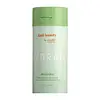What's inside
What's inside
 Key Ingredients
Key Ingredients

 Benefits
Benefits

 Concerns
Concerns

 Ingredients Side-by-side
Ingredients Side-by-side

Water
Skin ConditioningCaprylic/Capric Triglyceride
MaskingGlycerin
HumectantCetyl Ethylhexanoate
EmollientCetearyl Alcohol
EmollientDicaprylyl Carbonate
EmollientButylene Glycol
HumectantGlyceryl Stearate
EmollientIsododecane
EmollientMaltodextrin
AbsorbentSyringa Vulgaris Extract
Skin ConditioningTrifolium Pratense Flower Extract
AstringentHibiscus Sabdariffa Flower Extract
Skin ConditioningWithania Somnifera Root Extract
Skin ConditioningApium Graveolens Extract
Skin ConditioningHydroxyethyl Acrylate/Sodium Acryloyldimethyl Taurate Copolymer
Emulsion StabilisingPolyacrylate Crosspolymer-6
Emulsion StabilisingEthylhexylglycerin
Skin ConditioningFructose
HumectantSorbitan Isostearate
Emulsifying1,2-Hexanediol
Skin ConditioningBiosaccharide Gum-4
Skin ConditioningTocopherol
AntioxidantPolylysine
Potassium Sorbate
PreservativeCitric Acid
BufferingSodium Benzoate
MaskingPhenoxyethanol
PreservativeWater, Caprylic/Capric Triglyceride, Glycerin, Cetyl Ethylhexanoate, Cetearyl Alcohol, Dicaprylyl Carbonate, Butylene Glycol, Glyceryl Stearate, Isododecane, Maltodextrin, Syringa Vulgaris Extract, Trifolium Pratense Flower Extract, Hibiscus Sabdariffa Flower Extract, Withania Somnifera Root Extract, Apium Graveolens Extract, Hydroxyethyl Acrylate/Sodium Acryloyldimethyl Taurate Copolymer, Polyacrylate Crosspolymer-6, Ethylhexylglycerin, Fructose, Sorbitan Isostearate, 1,2-Hexanediol, Biosaccharide Gum-4, Tocopherol, Polylysine, Potassium Sorbate, Citric Acid, Sodium Benzoate, Phenoxyethanol
Water
Skin ConditioningGlycerin
HumectantEthylhexyl Palmitate
EmollientParaffinum Liquidum
EmollientCetearyl Alcohol
EmollientGlyceryl Stearate
EmollientPEG-100 Stearate
Bifida Ferment Filtrate
Skin ConditioningTheobroma Cacao Seed Butter
EmollientActinidia Chinensis Fruit Extract
EmollientSodium Hyaluronate
HumectantDimethicone
EmollientTremella Fuciformis Polysaccharide
Emulsion StabilisingCarbomer
Emulsion StabilisingPolyacrylamide
C13-14 Isoparaffin
EmollientLaureth-7
EmulsifyingButylene Glycol
HumectantEthylhexylglycerin
Skin ConditioningCaprylhydroxamic Acid
Sodium Hydroxide
BufferingPhenoxyethanol
PreservativeWater, Glycerin, Ethylhexyl Palmitate, Paraffinum Liquidum, Cetearyl Alcohol, Glyceryl Stearate, PEG-100 Stearate, Bifida Ferment Filtrate, Theobroma Cacao Seed Butter, Actinidia Chinensis Fruit Extract, Sodium Hyaluronate, Dimethicone, Tremella Fuciformis Polysaccharide, Carbomer, Polyacrylamide, C13-14 Isoparaffin, Laureth-7, Butylene Glycol, Ethylhexylglycerin, Caprylhydroxamic Acid, Sodium Hydroxide, Phenoxyethanol
 Reviews
Reviews

Ingredients Explained
These ingredients are found in both products.
Ingredients higher up in an ingredient list are typically present in a larger amount.
Butylene Glycol (or BG) is used within cosmetic products for a few different reasons:
Overall, Butylene Glycol is a safe and well-rounded ingredient that works well with other ingredients.
Though this ingredient works well with most skin types, some people with sensitive skin may experience a reaction such as allergic rashes, closed comedones, or itchiness.
Learn more about Butylene GlycolCetearyl alcohol is a mixture of two fatty alcohols: cetyl alcohol and stearyl alcohol. It is mainly used as an emulsifier. Emulsifiers help prevent the separation of oils and products. Due to its composition, it can also be used to thicken a product or help create foam.
Cetearyl alcohol is an emollient. Emollients help soothe and hydrate the skin by trapping moisture.
Studies show Cetearyl alcohol is non-toxic and non-irritating. The FDA allows products labeled "alcohol-free" to have fatty alcohols.
This ingredient is usually derived from plant oils such as palm, vegetable, or coconut oils. There is debate on whether this ingredient will cause acne.
Due to the fatty acid base, this ingredient may not be Malassezia folliculitis safe.
Learn more about Cetearyl AlcoholEthylhexylglycerin (we can't pronounce this either) is commonly used as a preservative and skin softener. It is derived from glyceryl.
You might see Ethylhexylglycerin often paired with other preservatives such as phenoxyethanol. Ethylhexylglycerin has been found to increase the effectiveness of these other preservatives.
Glycerin is already naturally found in your skin. It helps moisturize and protect your skin.
A study from 2016 found glycerin to be more effective as a humectant than AHAs and hyaluronic acid.
As a humectant, it helps the skin stay hydrated by pulling moisture to your skin. The low molecular weight of glycerin allows it to pull moisture into the deeper layers of your skin.
Hydrated skin improves your skin barrier; Your skin barrier helps protect against irritants and bacteria.
Glycerin has also been found to have antimicrobial and antiviral properties. Due to these properties, glycerin is often used in wound and burn treatments.
In cosmetics, glycerin is usually derived from plants such as soybean or palm. However, it can also be sourced from animals, such as tallow or animal fat.
This ingredient is organic, colorless, odorless, and non-toxic.
Glycerin is the name for this ingredient in American English. British English uses Glycerol/Glycerine.
Learn more about GlycerinGlyceryl Stearate is a mix of glycerin and stearic acid.
It is used to stabilize the mixing of water and oil ingredients. By preventing these ingredients from separating, it can help elongate shelf life. It can also help thicken the product's texture.
As an emollient, it helps soften skin and supports barrier-replenishing ingredients.
In cosmetics, Glyceryl Stearate is often made from vegetable oils or synthetically produced.
This ingredient may not be fungal-acne safe
Fun fact: The human body also creates Glyceryl Stearate naturally.
Learn more about Glyceryl StearatePhenoxyethanol is a preservative that has germicide, antimicrobial, and aromatic properties. Studies show that phenoxyethanol can prevent microbial growth. By itself, it has a scent that is similar to that of a rose.
It's often used in formulations along with Caprylyl Glycol to preserve the shelf life of products.
Water. It's the most common cosmetic ingredient of all. You'll usually see it at the top of ingredient lists, meaning that it makes up the largest part of the product.
So why is it so popular? Water most often acts as a solvent - this means that it helps dissolve other ingredients into the formulation.
You'll also recognize water as that liquid we all need to stay alive. If you see this, drink a glass of water. Stay hydrated!
Learn more about Water